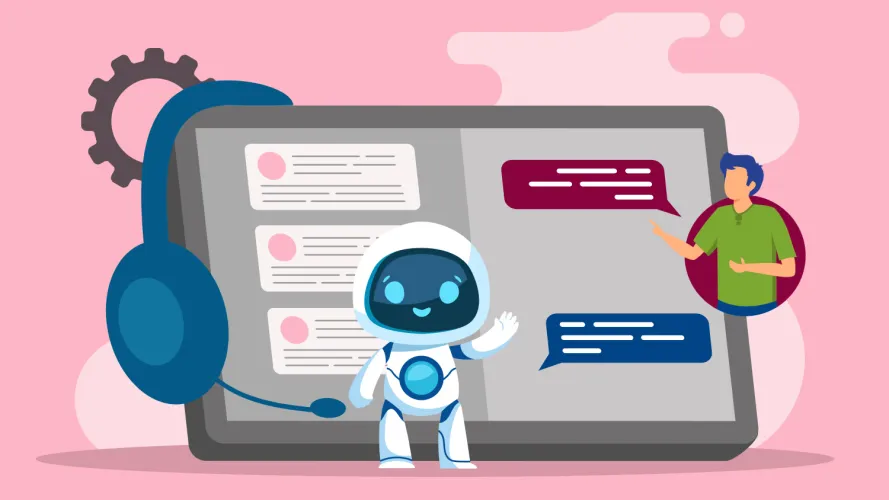Customer Service Channels: Your Quick Guide To the Top 6

Sometimes your customers want to use self-service, but other times they want to speak to a service representative. Here's how to make it easy for your customers to contact you.
How much effort do you have to spend contacting customer support to get a problem solved? More than you think is necessary, right? Just like you, customers are busy people who want their issues resolved quickly. It helps to offer multiple ways to reach your team – so people can contact your business when they have the time, on the customer service channel that’s most convenient for them.
But which channels should you offer? The key is to be where your customers want to be – and that’s probably more than just a single channel. In fact, our research finds that high-performing organizations provide service across a broader range of channels than underperformers. And 84% of decision makers say they’re reevaluating their channel resourcing this year.
We’ve gathered insights on the most popular channels today from service leaders. Here’s what you need to know to make sure you have the right ones for your customer service operations.
Get started with Voice AI
Discover the five ways Voice AI can deliver personalized, intelligent, 24/7 self-service by phone — customers #1 preferred channel.



The top customer service channels you need now
Consider these customer service channels for your business.
1. Self-service channels help customers solve simple issues themselves
Our research found that 61% of customers would rather use self-service for simple issues. Self-service also solves an estimated 54% of customer issues, on average, at organizations that use it.
Self-service includes your help center (also known as a knowledge base) and customer portal. Customers visit your help center to find answers to common questions. With customer portals, they can log in to an authenticated, branded site to access their information, such as past purchases, and to initiate easy step-by-step processes, like requesting a return. They get a personalized experience, including article recommendations and other offers and suggestions based on their user history. You can even deploy AI (like Salesforce’s Agentforce) in your portal to give customers support via an autonomous AI agent around the clock.
To keep your self-service channels up-to-date, regularly review your case information to make sure your knowledge base addresses common customer questions. What are customers routinely asking? Are new trends emerging? Use these insights to create new knowledge base articles that address common requests.
You can use Agentforce to create the first draft of a new knowledge base article. Be sure to have a human review the draft and edit for accuracy. Also include target keywords so that your content is easily accessible on your site and through search engines. We recommend evenly distributing your keyword throughout your article: once in the opening paragraph, in at least two of the H2 subheadings, and at least once in each section of the article.
2. Agentforce supports customers 24/7 across channels
AI agents, like Salesforce’s Agentforce, are the next wave of technological innovation in customer service – and they can be deployed across any service channel. Unlike the chatbots of the past, which worked through rules and preprogrammed scenarios, autonomous AI agents can understand the context and intent of a customer’s question. They use advanced technology like natural language processing (NLP) to parse what a customer has said, and can respond in a conversational, context-appropriate way.
Salesforce’s Agentforce can come up with a plan to help, and take action to resolve the customer’s issue. This means that Agentforce AI agents act as independent members of your service team, deflecting repetitive tasks so that service reps can focus on higher value ones. Agentforce is easy to set up: you can use natural language instructions to teach it how to identify and resolve the customer’s issues, or take action on the customer’s behalf. You can also set up parameters for when Agentforce shouldn’t handle the issue alone.
Instead, Agentforce can seamlessly transfer the interaction to a service rep when a human needs to make the decision – like whether to approve a refund – or when the inquiry is out of scope.
One of the major advantages of Agentforce over traditional chatbots is that it actually learns from interactions with customers. This means Agentforce gets smarter over time – it improves its ability to help your customers.
Prepare your org for Agentforce
Want to get the most out of digital labor? Our exclusive guide covers the best practices you need to know.



3. Chat offers quick resolutions and lowers costs
Customers may want to speak with a service representative, but it’s not always convenient to pick up the phone. That’s where live chat comes in. Nearly nine in 10 high-performing service organizations offer chat – compared with only 60% of underperforming service organizations.
Chat offers multiple benefits, for both your support team and your customers. For customers, it can be the perfect way to have a quick interaction to address a simple issue. For contact centers, embracing chat reduces call volumes. Since phone is the most expensive contact center channel, shifting calls to chat lowers costs-to-serve. With chat, reps can handle multiple customer interactions at once – unlike phone calls which service reps can only take one at a time. This shortens wait times for customers and speeds up issue resolution.
4. SMS & messaging apps meet customers where they spend time daily
Today’s customers are frequently on their phones, making SMS and messaging apps important service channels. These channels are convenient, and often have fast response times. Plus, text and messaging apps provide a record of past interactions.
Among service organizations, use of messenger apps – like Facebook Messenger, WhatsApp, and Apple Messages for Business – is on the rise. Our research finds that 79% of service organizations now use messenger apps, up from 70% in 2020.
5. Phone remains a top channel for customers with complex matters
Voice is still a top channel for customer service, especially for complex issues. When you combine your CRM with cloud telephony, voice becomes a faster, more personalized resolution channel for customers. The technology puts all call information on the support rep’s screen and transcribes the interaction so that the rep doesn’t have to take notes.
And with advances in technology, AI can now bring all of the benefits of AI agents to your voice channel. Autonomous AI agents deployed on your voice channel understand the customer’s inquiry, and can take steps to resolve the issue. This is a technological leap forward from clunky Interactive Voice Response (IVR) systems, which often leave customers frustrated and pressing 0 to speak to a representative.
For service reps helping customers on the voice channel, Agentforce acts as a virtual AI assistant – surfacing relevant knowledge articles, or summarizing a call once it’s over – just as it would on any other channel. This helps reps be more productive and stay focused on the customer.
Join the Serviceblazer Community on Slack


6. Email remains a tried-and-true support option
A vast majority of service organizations (90%, our research finds) offer email support. An oldie but goodie, email is great for asynchronous communication. Customers can email you whenever they have a moment, and get a record of the conversation to refer to, right in their inbox.
Connect your channels and data to deliver seamless support
It’s not enough to just be available for customers across various channels. You must also connect your service channels with both customer data and your unique business data (about your products, services, and processes).
When channels are connected to customer data, both service reps and AI agents see your customer’s history with your company. No matter how the customer reaches out, the support team has context – so customers don’t have to repeat themselves.
When you connect your channels and your business data, both reps and AI agents have the information they need to help, right at their fingertips. Some of this data is stored in your knowledge base with Salesforce (or another provider), while some may reside in external systems. With Unified Knowledge and Data Cloud, Salesforce can bring in all this data across systems and connect it all seamlessly to your AI model. The data grounds your AI model so that it can generate accurate responses that are personalized to your customers’ specific needs and preferences.
For example, when a customer reports a lost credit card, your AI agent can access the relevant knowledge base article and offer the customer guidance on how to resolve the issue.
Or, if the customer opts to speak with a service rep, Agentforce can support the service rep by generating suggested replies to customers, and proposing next steps to solve the issue. When the case is complete, Agentforce can even draft a case wrap-up summary, which the rep can then review and edit as needed.
AI is an exciting innovation – but if you’re just getting started with your channel strategy, I suggest starting by building a solid foundation before you launch AI. First, give your teams a complete view of data on a single platform, with the ability to manage cases across channels without having to toggle between different systems.
Take a step further by connecting service to your broader organization. Companies that connect service with sales, marketing, and commerce are better equipped to deliver a personalized customer experience across every touchpoint.
Last thoughts on customer service channel strategy
Regularly review customer service analytics to ensure your teams always meet expectations for fast, flexible, and quality service. Your channel selection depends entirely on the services you offer; what works well for a retailer may not work for a manufacturer. Test out different channels to see what resonates with your customers. And above all, keep an eye on customer service trends, so you can stay ahead of the game.
Meet Agentforce
Watch Agentforce resolve cases on its own, deliver trusted answers, engage with customers across channels and seamlessly hand off to human service reps.



Rekha Srivatsan contributed to this blog article.

























